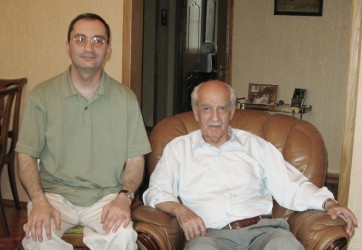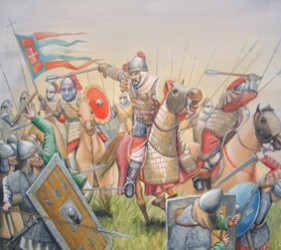Dec 13 2013
Review by Raffaele D’Amato
Comments Off on Review by Raffaele D’Amato
Jul 18 2013
Short English Summary
of
CLANDESTINE OPERATIONS BY THE ARMENIAN INTELLIGENCE IN THE 1720S
by Armen Ayvazyan
Starting from the late 17th century, the Armenians were secretly planning an all-out uprising against the Persian Safavi empire (the details on this uprising could be found in A. Ayvazyan’s The Armenian Rebellion of the 1720s and the Threat of Genocidal Reprisal).
Their decades-long preparations and strategy, among other things, called for the three sets of clandestine activities: (1) production, procurement and smuggling of arms and ammunition; (2) the conduct of negotiations with the governments of Christian Europe and Russia about getting their military backing to the Armenian liberation attempts; and (3) the training of the Armenian officers and soldiers abroad, in several east European countries and Russia, with the aim of their prompt arrival into Armenia at the very outset of the uprising. The vigorous implementation of these activities resulted, inter alia, in the extensive Armenian network of foreign agents covering Iran, the Ottoman Empire, Russia, Rzeczpospolita Polska (Polish–Lithuanian Commonwealth), Hungary, Crimea, Habsburg Monarchy (Holy Roman Empire), Wallachia, as well as, according to one of the archival documents, “other countries.” The Armenian foreign intelligence “stations” were established in Kamianets-Podilskyi (at the time, the strongest fortress in Poland, currently a city in Ukraine), Tabriz and Isfahan (Iran), Moscow, the cities of the Crimean Khanate (then the protectorate of the Ottoman Empire) and elsewhere. Parenthetically, in April of 1724, the powerful Tabriz station was partly uncovered and thirty of its members were executed by the Iranian authorities.
To very briefly illustrate the capacity of this Armenian foreign intelligence network, here it will suffice to mention just a few facts.
In 1722, 285 Armenian soldiers were secretly transported from Crimea to eastern/Persian Armenia across the hostile territory of the Ottoman Empire. This was one of the most successful operations of the Armenian intelligence in the 1720s.
About 500 Armenians – “all military men, disguised as traders,” as they claimed to the astounded Russian officials in 1727 – were secretly organized and scattered in small independent squads/cells throughout Poland, Hungary, Wallachia and some other neighboring regions of east Europe. Their command and control was performed by the troika of highest officers, going under the (probably fake) names of Isahak, Martiros, and Manuk who were usually based in Kamianets-Podilskyi. The exact locations, the numbers and the commanders of each squad were known and responsible to these three superiors only. On the contrary, neither the rank-and-file soldiers, nor seemingly some of the Armenian commanders had any definite idea about their exact identity or the whereabouts of their regional headquarters. In winter of 1727-1728, the troika called a general assembly of these well-trained and motivated forces in Poland and tried to organize their immediate transfer to Armenia via Russia. This emergency moving was most probably ordered from Armenia by the leaders of the liberation movement who exactly in 1727-1728 were fighting against the increasingly overwhelming odds, beating back many Ottoman charges into the besieged mountainous provinces of Karabakh (Artsakh) and Ghapan (Syunik) in eastern Armenia. In 1728, at least two Armenian detachments were allowed by the Russian authorities to pass from Rzeczpospolita Polska through vast Russian territory and ultimately the narrow wedge controlled by the Ottoman troops and their Caucasian allies to Armenia. Successfully entering Karabakh, they took part in the ongoing hostilities against the invading Ottoman armies.
In fact, the secret militarized grouping directed by the Kamianets-Podilskyi station of the Armenian intelligence was perhaps the largest ethnic organization of its kind in Europe of the XVIII century. These findings are valuable addition to our knowledge about the history of intelligence and espionage.
Below are the links to both the Armenian and Russian versions, published respectively in Hayastani Zrutzakitz (in Arm.) and Sobesednik Armenii (in Rus.):
Հայկական հետախուզության
Հայկական հետախուզության
Հայկական հետախուզության
Հայկական հետախուզության
Հայկական հետախուզության
Тайные операции армянской разведки в 1720-х гг. (V)
Тайные операции армянской разведки в 1720-х гг. (IV)
Тайные операции армянской разведки в 1720-х гг. (III)
Apr 19 2013
 By Armen Ayvazyan | April 15, 2013 | 12:00 AM
By Armen Ayvazyan | April 15, 2013 | 12:00 AM
Source: Harvard International Review
Since regaining independence in 1991, Armenia’s presidential elections have been marred by fraud, while the incumbent political authorities have consistently been able to reestablish themselves. Massive post-election protests took place after the presidential elections in 1996, 2003, and 2008. In 2013, the country found itself in a similar situation. With over 58 percent of the votes, the incumbent, President Serzh Sargsyan, was declared the winner, while Raffi Hovannisian, the leader of the Heritage Party, received about 37 percent of the vote.
Unique to the 2013 elections was that they were likely manipulated before the formal start of the campaign, as all major opposition political parties ultimately sat out of the elections. Not only did the Prosperous Armenia Party (PAP), the Armenian Revolutionary Federation (ARF), and the opposition bloc Armenian National Congress (ANC) refuse to nominate or support any candidate, but they also relinquished their organizational capabilities for monitoring the electoral process. Moreover, these parties did not call for elections boycott per se, even though they expressed distrust in the existing democratic mechanisms for regime change. Since 1991, behind-the-scenes bargaining between the government and the oppositional political forces has given rise to a loss of public trust in Armenia’s political institutions.
Mar 14 2013
 Բանասիրական գիտությունների թեկնածու, ԵՊՀ դոցենտ, թուրքագետ Լուսինե Սահակյանի «Համշենը անցյալի և ներկայի խաչմերուկներում» վավերագրական ֆիլմը արժանացել է Հոլիվուդում անցկացվող «Արփա» միջազգային կինոփառատոնի Արմին Վեգների անվան հեղինակավոր մրցանակին: Ֆիլմը շուտով կներկայացվի նաև Երևանում:
Բանասիրական գիտությունների թեկնածու, ԵՊՀ դոցենտ, թուրքագետ Լուսինե Սահակյանի «Համշենը անցյալի և ներկայի խաչմերուկներում» վավերագրական ֆիլմը արժանացել է Հոլիվուդում անցկացվող «Արփա» միջազգային կինոփառատոնի Արմին Վեգների անվան հեղինակավոր մրցանակին: Ֆիլմը շուտով կներկայացվի նաև Երևանում:
ԼՈՒՍԻՆԵ ՍԱՀԱԿՅԱՆԸ «Իրատես de facto»-ի հյուրն է:
-Ինչի՞ մասին է ֆիլմը: ՈՒղղված է ավելի շատ հա՞յ, թե՞ օտարազգի հանդիսատեսին:
-Ինչպես արդեն հուշում է վերնագիրը, իմ պատրաստած ֆիլմը ներկայացնում է 18-րդ դարում Օսմանյան կայսրությունում բռնի իսլամացված («թուրքացված») Համշենի հայության սերունդների ներկա վիճակը: Այսօր նրանք հիմնականում ապրում են ներկայիս Թուրքիայի Ռիզեի և Արդվինի, Էրզրումի, Սաքարիայի նահանգներում, ինչպես նաև Ստամբուլում և այլ քաղաքներում:
Ֆիլմում տեղ են գտել բացառիկ դրվագներ Համշենի հայկական երբեմնի հզոր իշխանության, մշակույթի մասին, ինչպես նաև մեկնաբանված է բռնի իսլամացման օսմանյան քաղաքականությունը, որը ոչ այլ ինչ էր, եթե ոչ ցեղասպանության մի տարատեսակ:
Ռիզեի և Արդվինի նահանգներում կատարված նկարահանումների հիման վրա ներկայացվում են համշենցիների այսօրվա մշակույթը` երգարվեստն ու պարը, սովորությունները, լեզուն, նաև կենցաղն ու զբաղմունքը, ինքնության հետ կապված նրանց ընկալումներն ու ժողովրդագրական պատկերը:
Հատկապես ցանկանում եմ շեշտել, որ նկարահանումները կատարել եմ 2010-12 թթ. Ռիզեի նահանգի Արդաշեն, Չամլըհեմշին, Հեմշին (Համշեն), Չայելի գավառների և Արդվինի նահանգի Խոփա գավառի, ինչպես նաև Էրզրումի նահանգի համշենցիների միջավայրում իրականացրած դաշտային աշխատանքների ընթացքում` ժողովրդագրական, բարբառագիտական, տեղանվանական նյութերի արձանագրմանը զուգահեռ: Այդ աշխատանքների ընթացքում հավաքած նյութերի մի մասն արդեն հրապարակել եմ գիտական հոդվածների և գրքի տեսքով: Հենց այս ուսումնասիրություններն էլ դարձել են հիմք ֆիլմի սցենարի համար: Սցենարի և ռեժիսորական աշխատանքների հեղինակը ես եմ:
Continue Reading »
Mar 12 2013
A RESPONSE
To Everett L. Wheeler’s review of The Armenian Military in the Byzantine Empire: Conflict and Alliance under Justinian and Maurice (Alfortville: Sigest, 2012)
By Armen Ayvazyan
I considered it a great honor, both for myself and my book, The Armenian Military in the Byzantine Empire: Conflict and Alliance under Justinian and Maurice (hereafter – the AM), that it was reviewed in The Journal of Military History (hereafter – JMH, 2013, No. 1, pp. 318-320), one of the most authoritative periodicals in the field it designates. The review, written by Everett L. Wheeler of the Duke University, presents the contents, the imprint and other particulars of the publication as follows: Glendale, Calif. (sic): Editions Sigest, 2012. ISBN: 978-2-91-732939-9 (sic). Note on Armenian personal names and toponyms. Illustrations. Maps. Notes. Appendixes. Bibliography. Index. Pp. 127.
In fact, the AM was printed in Alfortville (Paris, France) rather than Glendale (California, USA)! The words Glendale and California are nowhere to be found in the AM. The questions as to why and how they could have appeared in its review are disturbing. One may even wonder whether the reviewer has ever held the book in his hands, especially if considered that no page references are provided. Incidentally – or perhaps not incidentally – two of the four dashes within the ISBN number are misplaced too, not an inconsequential mistake in our digital age (the correct ISBN is 978-2-917329-39-9). These curious mistakes are only the first indications of the utterly unprofessional and tendentious character of Wheeler’s review.
In one and a half pages the reviewer manages to accuse me of representing “a super-nationalistic branch of Armenian historiography prominent since 1991,” while branding my book as “amateurish,” “‘old military history’ in one of its worst forms, featuring presentism and excessively speculative reconstructions of campaigns,” a “curious diatribe,” etc. Apparently to ensure full indoctrination of the uninitiated reader, the indictment in nationalism is reiterated in the closing sentence: “the work exemplifies a branch of contemporary nationalistic Armenian historiography better than serious scholarship.”
To see how successfully Wheeler is able to support these sweeping, politically colored, and offensive denunciations, below I will respond to all of his criticisms.
Mar 01 2013
Dec 24 2012
Հայկական Հետախուզութեան Աշխարհագրական Ընդգրկումը Շատ Լայն Եղած Է
ԿԱՏԻԱ ՔՈՒՇԵՐԵԱՆ
ԿԱՏԻԱ ՔՈՒՇԵՐԵԱՆ.- Պատմական եւ քաղաքական գիտութիւնների դոկտ. Արմէն Այվազեանի անունը քաջածանօթ է Հայաստանում եւ Սփիւռքում եւ ձեր գիտական գործունէութիւնը մեծապէս գնահատուած: Ձեր ուսումնասիրութիւնները լոյս են սփռում չարծարծուած կամ քիչ արծարծուած , եւ, որ ամէնակարեւորն է, հայոց պատմութեան յաղթական եւ ուժեղ երեսների վրայ: Վերջերս դուք յօդուածաշար էք հրապարակել, նուիրուած 18րդ դարի առաջին քառորդի հայկական հետախուզութեան գաղտնի գործողութիւնների վերաբերեալ: Խնդրում ենք անդրադառնաք այդ նիւթին:
ԱՐՄԷՆ ԱՅՎԱԶԵԱՆ.- Հայկական գաղտնի հետախուզութիւնը սկիզբ է առնում հնագոյն ժամանակներից: Հին եւ միջնադարեան հայկական թագաւորութիւնները ունեցել են իրենց յատուկ ծառայութիւնը, որ այսօրուայ եզրը գործածելով, կարելի է կոչել արտաքին հետախուզութիւն: Հայկական պետականութեան կործանումով այդ կառոյցը, որպէս պետական կառոյցի մաս, վերացաւ: Հետեւաբար, 1720ական թթ. , անկախ պետականութեան բացակայութեան պայմաններում հետախուզական հզօր ցանցի առկայութիւնը հայ իրականութեան մէջ, պատմականօրէն անհաւատալի երեւոյթ է: Սակայն այդպիսի մի մեծ ցանց իրօք գործում էր, ընդգրկելով Արեւելեան Եւրոպայի մի շարք երկրներ, Ռուսաստանը, Իրանը եւ Օսմանեան կայսրութիւնը:
Continue Reading »
Sep 03 2012
Հունգարիայի կողմից ադրբեջանցի մարդասպանի հանձնումն Ադրբեջանին ստեղծում է հայ ժողովրդի համար վաղուց ծանոթ հերթական իրավիճակը, երբ նրա թուրք-ադրբեջանական հարևանների ցեղասպանական քաղաքականությունն ու մղումները, աշխարհաքաղաքական ինչ-ինչ հաշվարկներից ելնելով, ոչ միայն չեն սաստվում, այսպես կոչված, միջազգային համայնքի, այն է՝ հզոր տերությունների կողմից, այլև բացահայտորեն խրախուսվում են։
May 09 2012

Հոդվածս նվիրում եմ հայրենասեր գործիչ,
Խորհրդային Միության հերոս
Գևորգ Վարդանյանի պայծառ հիշատակին
Jan 09 2012
 2011 թ. դեկտեմբերի 2-ին ՀՀ Երևան քաղաքի Կենտրոն և Նորք-Մարաշ վարչական շրջանների ընդհանուր իրավասության դատարանը (նախագահությամբ դատավոր` Ռ. Ներսիսյանի) իր վարույթում գտնվող թիվ ԵԿԴ 1051(02)11 գործով կայացրել և հրապարակել է վճիռ, որով մերժել է իմ (այսուհետև՝ հայցվոր)՝ Ա. Այվազյանի կողմից ընդդեմ պատասխանող` Հ. Դեմոյանի ներկայացված «Պատվի, արժանապատվության և գործարար համբավի պաշտպանության պահանջի մասին» հայցը: Վճիռն անհիմն է և այն պետք է բեկանել հետևյալ պատճառաբանությամբ։
2011 թ. դեկտեմբերի 2-ին ՀՀ Երևան քաղաքի Կենտրոն և Նորք-Մարաշ վարչական շրջանների ընդհանուր իրավասության դատարանը (նախագահությամբ դատավոր` Ռ. Ներսիսյանի) իր վարույթում գտնվող թիվ ԵԿԴ 1051(02)11 գործով կայացրել և հրապարակել է վճիռ, որով մերժել է իմ (այսուհետև՝ հայցվոր)՝ Ա. Այվազյանի կողմից ընդդեմ պատասխանող` Հ. Դեմոյանի ներկայացված «Պատվի, արժանապատվության և գործարար համբավի պաշտպանության պահանջի մասին» հայցը: Վճիռն անհիմն է և այն պետք է բեկանել հետևյալ պատճառաբանությամբ։
Jan 09 2012
 Լուսինե Սահակյան
Լուսինե Սահակյան
Բանասիրական. գիտ. թեկնածու,
Հոդվածը լույս է տեսել «Ձայն համշենական» ամսաթերթում, 2011, NN 9-10 սեպտեմբեր-հոկտեմբեր։
2011թ. ամռանը ևս բարբառագիտական և ժողովրդագրական հետազոտություններ կատարելու նպատակով այցելեցինք Ռիզեի նահանգի Չամլըհեմշին գավառ և Չայելի (հնում՝ Մափավրի) գավառի Սենոզի շրջանի համշենցիների բնակավայրեր։ Մեր խմբի կազում էր ՀՀ ԳԱԱ հնագիտության և ազգագրության ինստիտուտի գիտաշխատող, Հայաստանի «Համշեն» հայրենակցական-բարեգործական հ/կ փոխնախագահ, «Ձայն համշենական» ամսաթերթի գլխավոր խմբագիր Սերգեյ Վարդանյանը։
May 28 2011
 538-539 թթ. հայոց ապստամբությունը (պատմառազմագիտական վերլուծություն). I
538-539 թթ. հայոց ապստամբությունը (պատմառազմագիտական վերլուծություն). I
Արմեն Այվազյան,
«ՀԱՅԱՍՏԱՆԻ ԶՐՈՒՑԱԿԻՑ»,
#20 (183), 27 մայիսի, 2011 թ.
Армянское восстание 538-539 гг. (военно-исторический анализ). I
Армен Айвязян,
“Собеседник Армении”,
#20 (183),27 мая 2011 г.